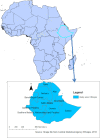Spatial distribution and factors associated with low birth weight in Ethiopia using data from Ethiopian Demographic and Health Survey 2016: spatial and multilevel analysis
- PMID: 34036183
- PMCID: PMC8103935
- DOI: 10.1136/bmjpo-2020-000968
Spatial distribution and factors associated with low birth weight in Ethiopia using data from Ethiopian Demographic and Health Survey 2016: spatial and multilevel analysis
Abstract
Objective: This study aimed to assess the spatial distribution, individual and community-level factors associated with low birth weight in Ethiopia.
Method: Secondary data analysis was conducted using the 2016 Ethiopian Demographic and Health Survey data. A total of 2110 neonates were included in this study. Spatial autocorrelation analysis was conducted to assess the spatial clustering of LBW. Besides, the spatial scan statistics and ordinary kriging interpolation were done to detect the local level clusters and to assess predicted risk areas, respectively. Furthermore, a multilevel logistic regression model was fitted to determine individual and community-level factors associated with LBW. Finally, most likely clusters with log-likelihood ratio (LLR), relative risk and p value from spatial scan statistics and adjusted OR (AOR) with 95% CI for multilevel logistic regression model were reported.
Results: LBW was spatially clustered in Ethiopia. Primary (LLR=11.57; p=0.002) clusters were detected in the Amhara region. Neonates within this spatial window had a 2.66 times higher risk of being LBW babies as compared with those outside the window. Besides, secondary (LLR=11.4; p=0.003; LLR=10.14, p=0.0075) clusters were identified at southwest Oromia, north Oromia, south Afar and southeast Amhara regions. Neonates who were born from severely anaemic (AOR=1.40, 95% CI (1.03 to 2.15)), and uneducated (AOR=1.90, 95% CI (1.23 to 2.93)) mothers, those who were born before 37 weeks of gestation (AOR=5.97, 95% CI (3.26 to 10.95)) and women (AOR=1.41, 95% CI (1.05 to 1.89)), had significantly higher odds of being LBW babies.
Conclusion: The high-risk areas of LBW were detected in Afar, Amhara and Oromia regions. Therefore, targeting the policy interventions in those hotspot areas and focusing on the improvement of maternal education, strengthening anaemia control programmes and elimination of modifiable causes of prematurity could be vital for reducing the LBW disparity in Ethiopia.
Keywords: epidemiology; health services research; neonatology.
© Author(s) (or their employer(s)) 2021. Re-use permitted under CC BY-NC. No commercial re-use. See rights and permissions. Published by BMJ.
Conflict of interest statement
Competing interests: None declared.
Figures





Similar articles
-
Spatial distribution of short birth interval and associated factors among reproductive age women in Ethiopia: spatial and multilevel analysis of 2019 Ethiopian mini demographic and health survey.BMC Pregnancy Childbirth. 2023 Apr 22;23(1):275. doi: 10.1186/s12884-023-05610-9. BMC Pregnancy Childbirth. 2023. PMID: 37087447 Free PMC article.
-
Spatial distribution of stillbirth and associated factors in Ethiopia: a spatial and multilevel analysis.BMJ Open. 2020 Oct 28;10(10):e034562. doi: 10.1136/bmjopen-2019-034562. BMJ Open. 2020. PMID: 33115888 Free PMC article.
-
Spatial variation and factors associated with home delivery after ANC visit in Ethiopia; spatial and multilevel analysis.PLoS One. 2022 Aug 25;17(8):e0272849. doi: 10.1371/journal.pone.0272849. eCollection 2022. PLoS One. 2022. PMID: 36007083 Free PMC article.
-
Geographical variation of common childhood illness and its associated factors among under-five children in Ethiopia: spatial and multilevel analysis.Sci Rep. 2023 Jan 17;13(1):868. doi: 10.1038/s41598-023-27728-8. Sci Rep. 2023. PMID: 36650192 Free PMC article.
-
Prevalence and determinants of low birth weight in Ethiopia: A multilevel meta-analysis and systematic review.Public Health. 2025 Feb;239:215-223. doi: 10.1016/j.puhe.2024.12.044. Epub 2025 Jan 30. Public Health. 2025. PMID: 39889649
Cited by
-
Spatial Distribution and Temporal Trends of Dietary Niacin Intake in Chinese Residents ≥ 5 Years of Age between 1991 and 2018.Nutrients. 2023 Jan 26;15(3):638. doi: 10.3390/nu15030638. Nutrients. 2023. PMID: 36771344 Free PMC article.
-
Spatial heterogeneity of low-birthweight deliveries on the Kenyan coast.BMC Pregnancy Childbirth. 2023 Apr 19;23(1):270. doi: 10.1186/s12884-023-05586-6. BMC Pregnancy Childbirth. 2023. PMID: 37076795 Free PMC article.
-
The effect of antenatal depression on birth weight among newborns in South Gondar zone, Northwest Ethiopia: a population-based prospective cohort study.Arch Public Health. 2021 Jul 5;79(1):121. doi: 10.1186/s13690-021-00643-y. Arch Public Health. 2021. PMID: 34225799 Free PMC article.
-
Spatial analysis and factors associated with low birth weight in Ghana using data from the 2017 Ghana Maternal Health Survey: spatial and multilevel analysis.BMJ Open. 2024 Aug 5;14(8):e083904. doi: 10.1136/bmjopen-2024-083904. BMJ Open. 2024. PMID: 39107031 Free PMC article.
-
Pooled prevalence and factors of low birth weight among newborns in the top 20 countries with the highest infant mortality: analysis of recent demographic and health surveys.BMJ Open. 2025 Apr 21;15(4):e098090. doi: 10.1136/bmjopen-2024-098090. BMJ Open. 2025. PMID: 40258643 Free PMC article.
References
-
- Hug L, Sharrow D, You D. Levels & trends in child mortality: report 2017. Estimates developed by the UN Inter-agency Group for Child Mortality Estimation; 2017.
-
- World Health Organization . Health in 2015: from MDGs, millennium development goals to SDGs, sustainable development goals; 2015.
-
- World Health Organization . International statistical classification of diseases and related health problems: World Health organization 2004.
-
- world health organization . Low birth weight deaths in Ethiopia 2017. Available: https://www.worldlifeexpectancy.com/ethiopia-life-expectancy
MeSH terms
LinkOut - more resources
Full Text Sources
Other Literature Sources
